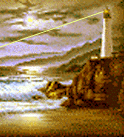

The Fifty Miracle Principles
of A Course in Miracles
by Kenneth Wapnick
Principle 38
The Holy Spirit is the mechanism
of miracles. He recognizes both God's creations and your illusions.
He separates the true from the false
by His ability to perceive totally rather than selectively.
This means that the Holy Spirit is a "switch-hitter" and, as the Course says later on, He is "the only part of the Trinity that has a symbolic function" (text, p. 67; T-5.1.4:1). This means He can function in a world of symbols. There are no symbols in Heaven, only in this world.
Q: If the separation is an illusion, and the Holy Spirit came into existence to solve that, is not the Holy Spirit an illusion?
A: No, because God created Him. It is a good question, though. The Course's answer is that when the separation is totally healed and the Holy Spirit is no longer needed, He still exists because God created Him. And then the Course says that He returns to Heaven and blesses our creations (text, p. 68; T-5. 1.5:7).
Q: But it seems like He was created to solve a problem that does not exist.
A: That is right, and because he was created by God, which really means He is just an extension of God, once He does that, He cannot disappear. His function is an illusion, for it is to correct a problem which is inherently illusory, which means that this function, too, must be an illusion, as is the form in which the content of His Love is experienced by us.
Q: But He is one of us ...
A: No, He is not one of us. We are part of the Second Person of the Trinity -- Christ -- and the Holy Spirit is the Third Person of the Trinity. On another level, of course, the Trinity is One. Nonetheless, A Course in Miracles does speak of Levels of the Trinity. This is more than a fine, theological distinction. It is important to correct the idea that the Holy Spirit's Voice is our own. This is similar to the belief that we are God, which the Course quite clearly states we are not. To believe that God's Voice is our own, let alone that we are God Himself, is just another expression of the basic separation belief that got us all in trouble in the first place.
Q: You used another kind of example. You said that God sent the Holy Spirit into the dream; He is not part of the dream, but He came into the dream to speak to us within it.
A: The question still is, "What happens when the dream is over?" It is one of those things no one could understand anyway. I can just tell you what A Course in Miracles says about it. But the idea is that the Holy Spirit has a foot in reality, in Heaven, and He has a foot in the dream (assuming He has two feet). He is within the dream, but yet He is not part of the dream. He is within our separated minds and works within them; yet He also is in touch with the Christ Mind. He is like an intermediary.
God, of course, does not even know about the dream, or the world of illusion. An analogy would be that of a parent looking in on a sleeping child at night and seeing the child thrashing around, obviously having a nightmare. The parent does not know what the child is dreaming, for it is outside his or her mind, but the parent does know that the child is in pain and would obviously like to alleviate that pain. That is the situation God is in. Therefore, He extends Himself into the dream, into the mind of His sleeping Son. The "Holy Spirit" is the name A Course in Miracles gives to this extension, the Voice for God. And within that dream He tells us, "My brother, choose again. You can look at your dream differently." Thus, He screens out what does not truly meet our need; i.e., special relationships. He helps us to unify our perception, to see all things as lessons God would have us learn. That is what is meant by "He separates the true from the false," and "to perceive totally rather than selectively." That was the point I was making earlier, that He would see all aspects of a situation. We would see a situation only in terms of our specific needs. He recognizes all situations as opportunities for healing all people who are involved.
Q: The aspect of the Holy Spirit that has one foot in one world, Heaven, and another foot in our world, the dream -- does that mean that He can have both knowledge and perception at the .same time?
A. Right.
Q: What does the Course mean by teaching that we are never in the wrong place at the wrong time?
A: We can never be in the wrong place at the wrong time because we can always learn from any and every thing. The Holy Spirit can use all situations and relationships to teach us the single lesson that the separation is unreal. On a deeper level, the statement reflects the idea that the script is already written. We have already been through all this. We are merely, as the Course says, reviewing mentally what has already gone by (workbook, p. 291; W-pI.158.4:5). And we can review or re-experience what has already happened either by choosing the ego or the Holy Spirit. Therefore, being in the right or wrong place has no meaning. The way that we review this place gives it its meaning.